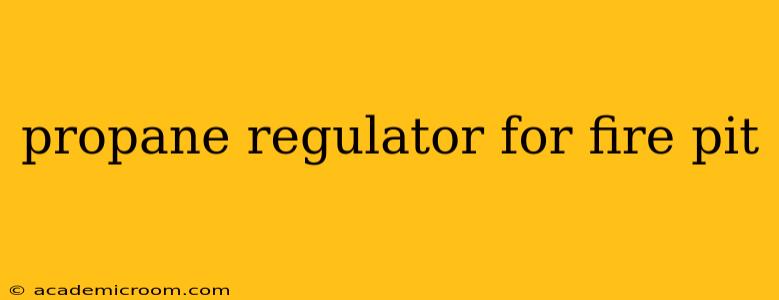Choosing the right propane regulator for your fire pit is crucial for safety and optimal performance. A faulty or improperly sized regulator can lead to insufficient flame, dangerous gas leaks, or even explosions. This comprehensive guide will walk you through everything you need to know to select and maintain the perfect propane regulator for your outdoor enjoyment.
What is a Propane Regulator?
A propane regulator is a safety device that reduces the high pressure of propane gas from the tank to a safe, usable pressure for your fire pit's burner. Propane tanks typically store gas at around 200 PSI (pounds per square inch), which is far too high for direct use in most appliances. The regulator lowers this pressure to approximately 11 inches of water column (WC), the standard for most outdoor propane applications like fire pits. This pressure reduction is essential for safe and controlled combustion.
What are the Different Types of Propane Regulators?
Several types of regulators exist, each designed for specific applications and flow rates. While many fire pits use standard regulators, understanding the differences can help ensure optimal performance and safety.
1. Single-Stage Regulators:
These are the most common type found on smaller fire pits. They perform a single pressure reduction step from the tank pressure to the low-pressure output. They are generally inexpensive and reliable for most residential fire pits.
2. Two-Stage Regulators:
Two-stage regulators provide a more precise pressure reduction by performing the reduction in two steps. This results in better pressure control and stability, especially beneficial for larger fire pits or those with high BTU output burners. However, they are generally more expensive.
3. High-Pressure Regulators:
These regulators are used for appliances requiring higher gas pressures. They are rarely needed for standard fire pits, unless you have a specialized high-output model. Using an incorrect regulator type is dangerous and should be avoided.
How to Choose the Right Propane Regulator for Your Fire Pit?
Selecting the correct propane regulator hinges on several factors:
- BTU Rating of your Fire Pit: Higher BTU ratings require regulators with greater flow capacities. Check your fire pit's specifications for the recommended BTU output and select a regulator accordingly.
- Type of Fire Pit: Different fire pit designs may necessitate specific regulator types. Refer to your fire pit’s manual for guidance.
- Size of Propane Tank: While not directly impacting regulator selection, the size of your tank influences the duration of your fire. Larger tanks generally require higher-capacity regulators for sustained high-BTU output.
- Safety Certifications: Ensure your regulator carries the appropriate safety certifications, such as CSA (Canadian Standards Association) or UL (Underwriters Laboratories).
What Size Propane Regulator Do I Need?
Determining the appropriate size involves understanding the regulator's flow rate (typically measured in cubic feet per hour or CFH). This figure directly relates to the fire pit's BTU rating. Consult your fire pit's manual for the recommended CFH or BTU rating. An undersized regulator will restrict the gas flow, resulting in a weak flame, while an oversized regulator may not pose an immediate danger, but could still impact efficiency.
How Often Should I Replace My Propane Regulator?
Propane regulators, like any other mechanical device, degrade over time due to wear and tear. The frequency of replacement depends on usage, environmental conditions, and the quality of the regulator. While there's no hard and fast rule, a good practice is to inspect your regulator annually and replace it every 5-7 years or if you notice any signs of damage, leaks, or decreased performance. Regular inspections for cracks, corrosion, or leaks are highly recommended.
Can I Use Any Propane Regulator on My Fire Pit?
No. Using the wrong regulator can lead to safety hazards. Always consult your fire pit's owner's manual for the recommended regulator specifications. Using an incompatible regulator may void your warranty and pose a significant safety risk. Incorrect pressure can lead to improper combustion, potentially resulting in carbon monoxide buildup or even a fire.
What are the signs of a faulty propane regulator?
A faulty regulator can manifest in various ways:
- Weak or inconsistent flame: Insufficient gas flow indicates a possible regulator problem.
- Gas leaks: A hissing sound or the smell of propane gas points to a serious leak requiring immediate attention.
- Difficulty lighting the fire pit: Consistent ignition failure may signify a regulator malfunction.
If you notice any of these symptoms, immediately shut off the propane supply and contact a qualified professional for inspection and repair.
How do I maintain my propane regulator?
Regular maintenance extends the lifespan and ensures the safe operation of your regulator. Keep the regulator clean and free from debris. Avoid exposing it to extreme temperatures or harsh chemicals. Always inspect it before each use for signs of damage or leaks.
Choosing the correct propane regulator is paramount for both safety and efficient operation of your fire pit. By understanding the different types, sizing considerations, and maintenance practices, you can ensure many years of safe and enjoyable outdoor gatherings. Remember to always prioritize safety and consult professional assistance if you have any doubts or encounter any issues with your propane equipment.
